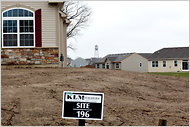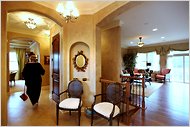Kim Meier’s spring promotion, which includes a $17,000 credit at a nearby General Motors dealer, has produced seven sales since the beginning of March, a veritable windfall of business for a builder who sold only 20 houses last year. “We needed to do something dramatic,” said Mr. Meier. “The market’s been soft.”
That is one way of putting it. The recession hurt a lot of industries, but it knocked the residential construction market to the mat and has kept it there, even as the broader economy has started to fitfully recover.
Sales of new single-family homes in February were down more than 80 percent from the 2005 peak, far exceeding the 28 percent drop in existing home sales. New single-family sales are now lower than at any point since the data was first collected in 1963, when the nation had 120 million fewer residents.
Builders and analysts say a long-term shift in behavior seems to be under way. Instead of wanting the biggest and the newest, even if it requires a long commute, buyers now demand something smaller, cheaper and, thanks to $4-a-gallon gas, as close to their jobs as possible. That often means buying a home out of foreclosure from a bank.
Four out of 10 sales of existing homes are foreclosures or otherwise distressed properties. Builders like Mr. Meier who specialize in putting up entire neighborhoods on a city’s outskirts — Richmond is some 50 miles northwest of downtown Chicago — cannot compete despite chopping prices.
Chicago was not an epicenter of the housing boom with the sort of overbuilding found in Arizona or Florida, but new-home sales in the metro area are down 90 percent. There are about 65 sales a week for a region of 10 million people.
Several factors have combined to make the Chicago market so weak. There were more subprime loans here, which meant more defaults, which in turn left more distressed homes for buyers to choose from.
Most of the construction here was done by private builders. Unlike the national firms, they did not have the resources to survive a prolonged downturn. “Some of the private builders just evaporated, and some said the hell with it,” said Tracy Cross, a consultant who tracks the local market. Only a few remain, including Mr. Meier’s KLM Builders.
Construction of new single-family homes usually surges after a recession because of lower rates and pent-up demand. But the Census Bureau said this week that while multi-unit construction had picked up strongly in the last year, single-family home construction fell 21 percent to an annual rate of 422,000. One consequence of the anemic pace: more than 1.4 million residential construction jobs have been lost in the last five years.
Robert Barycki is one of a handful of buyers keeping the market from drying up completely. He’s 30, a partner in a hardware store, and currently living with his parents. He was drawn by the new-car offer to the biggest of KLM’s four active developments, called Sunset Ridge Estates.
“My money was in the bank, collecting very little interest, so I thought I might as well take a little gamble,” said Mr. Barycki, who is paying $182,000 for a three-bedroom. “Eventually, home-owning will come back.”
Eventually, no doubt. But in the meantime, sentiment might still be souring. Executives at Equity LifeStyle Properties, a Chicago firm that sells properties in resort communities, said this week they were seeing “a psychological change”: potential customers wanted to preserve their capital rather than risk it in real estate.
Bill McBride, who runs the popular financial blog Calculated Risk, said this might be the moment when people decisively started to turn on home ownership. “I’m starting to feel the hate,” he wrote.
In such an atmosphere, every new home built and sold represents a victory. One of the few segments of the market that has shown signs of life is urban townhomes. Lennar, a national builder, has one of these developments under way in the upscale community of Arlington Heights, about 20 miles from downtown Chicago.
Then Pulte, another national builder, started construction on its own townhouse community a few miles away, even as it was recording a 2010 third-quarter loss of a billion dollars. In the meantime, Lennar cut its prices by another 10 percent, but sales in the fourth quarter barely budged.
Lennar says its sales have picked up and it is drawing customers from people who looked at Pulte’s project and passed. Pulte says the same thing about Lennar.
“It’s brutal out there,” said Mr. Cross, the consultant. “You have to put on your boxing gloves.”
Some victories may be brief. Builders say buyers have been acting ahead of a small rise in mortgage insurance premiums from the Federal Housing Administration, which backs many purchases. That mini-rush to lock in a deal might lift March sales figures for new homes, which are due out Monday, analysts say.
Mr. Meier, who has been building in this stretch near the Wisconsin border for 25 years, hopes the car promotion will put a floor under his market. In flush times, he would sell about 100 houses a year to a diverse group of buyers, from empty nesters to commuters.
Richmond bills itself as a “Village of Yesteryear,” which has come true in another way as house prices roll back to the mid-1990s. But some KLM buyers look for more, choosing to skip the car and put the $17,000 into the house instead.
That is what Wayne and Doris Powrozek, who are paying $193,000 for a three-bedroom, did. “If it’s free, it’s for me,” said Mr. Powrozek, who recently retired from AT&T.
The Powrozeks bought because they were worried prices were going up. Mr. Meier says he thinks they must — the cost of raw materials is rising. But with the price of existing homes continuing to fall, and the prospect of more foreclosures, he could again price himself out of the market.
Like nearly all those in real estate, Mr. Meier is determinedly optimistic. “Everybody wants in at the top, no one wants in at the bottom,” he said. “People are paralyzed by their fear.”
Last year, KLM told buyers it would match the government’s $8,000 tax credit. The car promotion more than doubles that. If the market still does not turn around, what could be their next promotion?
“Buy one, get one free,” his wife, Sally, suggested. They had a good laugh over that.




